Inclusive Design Principles
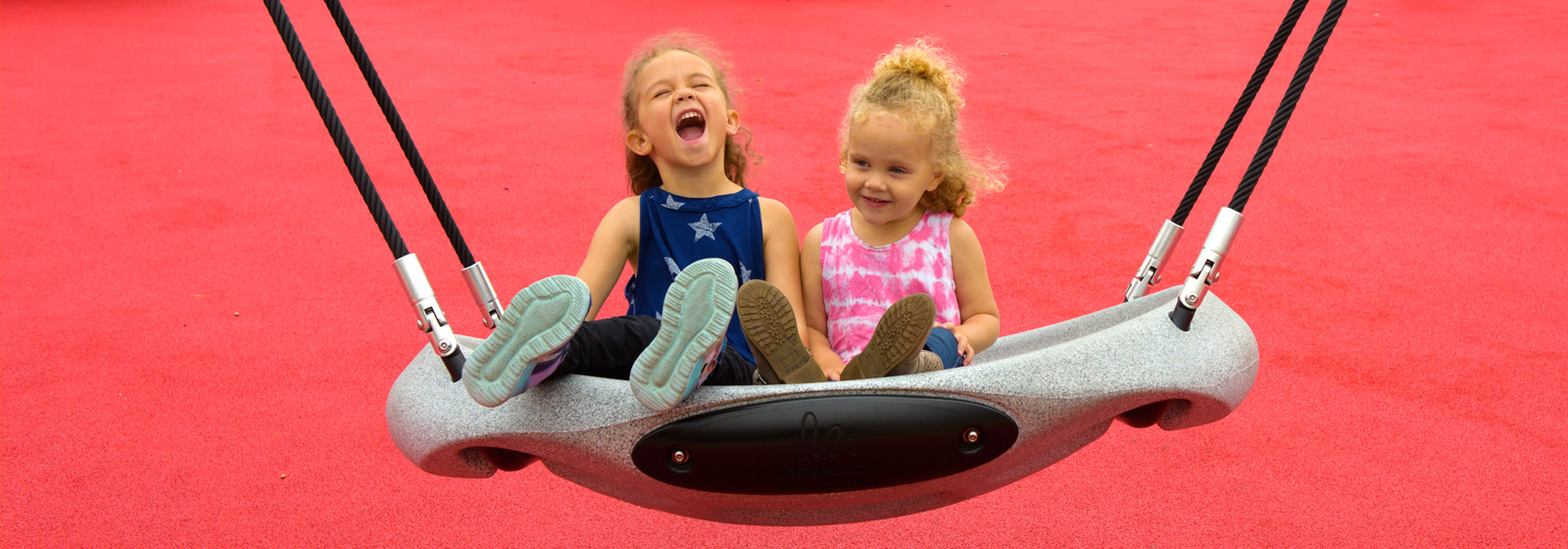
Inclusive Play Design
Play shapes all of us and everyone deserves the opportunity to play. A well-designed inclusive playground welcomes, supports and engages every person who comes to use the space regardless of the ability.

Our team of inclusive play experts are continuously striving to make play exceptional for everyone. We tap into the experience of our inclusive play experts as well as passionate parents, therapists and kids. Engaging the user voice and incorporating their feedback ensures our equipment and play space designs don’t just look good on paper, they work in practice too. It’s our “secret sauce” for developing exciting, interesting and inclusive playground elements that test and challenge all children, ultimately increasing the developmental benefits of play.
Inclusive Play Design Philosophy
Our playground architects create inclusive playgrounds featuring activities that are age and developmentally appropriate, sensory stimulating and universally designed. Our design philosophy is heavily influenced by the tenets of Universal Design, a theory of design that strives to make environments more usable, safer and healthier for all. This philosophy has been part of Landscape Structures' commitment since our co-founder, Steve King, was appointed to the Federal Access Board’s Recreation Access Advisory Committee in 1993.
Our team of designers, engineers and inclusive play experts follow the Seven Principles of Universal Design:
1. Equitable Use. The design is useful to people with diverse abilities.
2. Flexibility in Use. The design accommodates a wide range of individual preferences and abilities giving users a choice in how they engage each activity.
3. Simple and Intuitive Use. Use of the design is easy to understand regardless of the user's experience, knowledge, language skills or current concentration level.
4. Perceptible Information. The design communicates necessary information effectively to the user regardless of ambient conditions or the user's sensory abilities.
5. Tolerance for Error. The design minimizes hazards and the adverse consequences of accidental or unintended actions.
6. Low Physical Effort. The design can be used efficiently and comfortably.
7. Size and Space for Approach and Use. Appropriate size and space are provided for approach, reach, manipulation and use regardless of user's body size, posture or mobility.
Through Universal Design we increase access, safety, comfort and social participation within all our play environments. This process creates a strong foundation for inclusive playground design that ultimately results in a place where all can play, learn and grow together.
Inclusive Play Innovation
We have worked tirelessly to innovate and create new playground activities and elements that break barriers. From our Sway Fun® Glider launched in 2002 which was the first multi-rider accessible glider for kids and families of all abilities to our We-Go-Swing that delivers an accessible, no-transfer swing option to all wheelchair users. It’s also designed in a way so it can be a part of the playground alongside everything else. This swing is revolutionary because it gives everyone the option to propel and control their own motion and swing together. This innovation truly gives individuals of all abilities a chance to participate, imagine and enjoy one of the best parts of the playground and swing however they choose. 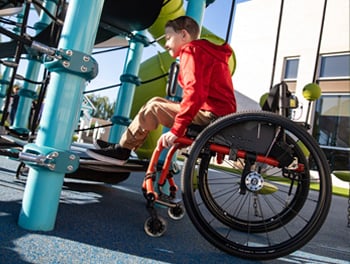 Landscape Structures is also pushing boundaries by using a belted material to create a comfortable climbing and thrilling challenge for children with disabilities. Our new belting on the Super Netplex®, Hedra® and Crab Trap® allows kids who are transferring out of their mobility devices, which we want to encourage and make rewarding, to traverse, build their motor planning skills and get to the highest point of the structure to engage in play.
Landscape Structures is also pushing boundaries by using a belted material to create a comfortable climbing and thrilling challenge for children with disabilities. Our new belting on the Super Netplex®, Hedra® and Crab Trap® allows kids who are transferring out of their mobility devices, which we want to encourage and make rewarding, to traverse, build their motor planning skills and get to the highest point of the structure to engage in play.
Designing Inclusive Playgrounds
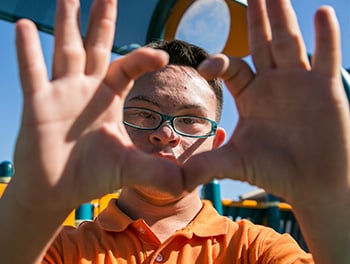 Our commitment to A Higher Level of Inclusive Play™ means going beyond a checklist approach to inclusive playground design and pushing past the minimum requirements placed for playgrounds by the Americans with Disabilities Act (ADA). We go beyond mere accessibly to include elements designed for children with down syndrome, sensory processing disorders, and visual and hearing impairments.
Our commitment to A Higher Level of Inclusive Play™ means going beyond a checklist approach to inclusive playground design and pushing past the minimum requirements placed for playgrounds by the Americans with Disabilities Act (ADA). We go beyond mere accessibly to include elements designed for children with down syndrome, sensory processing disorders, and visual and hearing impairments.
A focus on the following elements will ensure your play space is welcoming and supporting to all.
Play Experience. Playgrounds can offer many opportunities for children to further develop physical, cognitive, sensory and social skills. An inclusive playground design offers a multitude of play experiences to build these developmental benefit skills.
Sensory stimulation: A sensory-rich inclusive play environment can bring children together while providing each one with the sensory experiences they seek. Sensory activities can include a sand station for fine motor tactile stimulation or our Roller Slide and Roller Table for a bumpy sensation as a child slides down or across.
Swinging, spinning, sliding: Besides being fun, these activities sharpen our internal senses— vestibular (awareness of how our body moves through space and against gravity) and proprioception (awareness of body position and how much force is needed for an activity).
Inclusive playground elements like our We-Go-Swing®, We-Go-Round® and OmniSpin® Spinner gives users the opportunity to swing, spin and play face-to-face. It also offers exterior and interior engagement options so children can participate and choose how they want to move.
Social and imaginative play: As children challenge themselves physically, they also learn how to manage joy and frustration, friendship and conflict, through play with others. Learning cooperation and how the world works around them are invaluable life skills that begin during play.
Imaginary play is where kids experiment with rules and roles and identify their passions. Whether engaged in parallel play, quiet play or active social play, an inclusive playground provides plenty of opportunities for children to interact face-to-face and use their imagination.
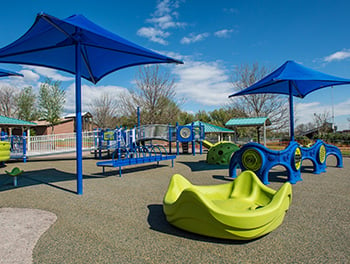 Variability. By including a variety of options on a play space – through different playground elements and ways in which a child can engage with those elements – there will be developmentally appropriate challenges that meets kids wherever they are at while letting them build comfortably on the skills they already possess.
Variability. By including a variety of options on a play space – through different playground elements and ways in which a child can engage with those elements – there will be developmentally appropriate challenges that meets kids wherever they are at while letting them build comfortably on the skills they already possess.
By striking this balance, children are encouraged to challenge themselves in ways they can control and manage. Risk, adventure and challenge are important elements of play for all ages and abilities. Challenge creates the opportunity for a child to gain a new skill and have the sensation of success when it’s mastered. Without risk and challenge, there is no feeling of success.
Too Small to Fail and Story Trails - Inclusion includes language, literacy, and social play. Today, almost 60 percent of children in the United States start kindergarten unprepared, lagging behind their peers in critical language and reading skills. Programs like Too Small to Fail (TSTF), an early childhood initiative of the Clinton Foundation, and Story Trails promote the importance of early brain and language development.
TSTF is meeting parents and caregivers where they are to help them prepare children for success in school and beyond. TSTF empowers caregivers with tools to talk, read and sing with young children. Landscape Structures DigiFuse® panels and Let’s Talk panels provide creative ways to promote early language and cognitive development through play.
When kids talk to each other, they learn from each other and in the case of inclusion, they’re learning about what they have in common, not just how they are different. Story Trails like the Able Fables showcase characters living perfectly able lives and shows disability in a way that teaches kids that it’s not something negative, just different.
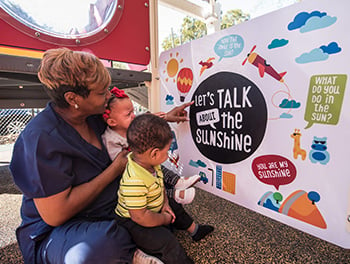 Safety, Comfort and Access. Creating a welcoming, safe and accessible environment is just as important as the play equipment you put in it. A well-designed environment makes the space more comfortable and user-friendly for children and families of all ages and abilities to use.
Safety, Comfort and Access. Creating a welcoming, safe and accessible environment is just as important as the play equipment you put in it. A well-designed environment makes the space more comfortable and user-friendly for children and families of all ages and abilities to use.
Fencing: A fence can help define and contain the activity area, providing a sense of comfort to both children and their parents. With the comfort and safety a fence provides, caregivers can allow their children to roam the playground and play freely.
Signage: Clear and easy to read signage makes people feel more comfortable when they have a good understanding of their surroundings. Pictures and symbols are an effective way for non-verbal, speech-challenged, and early-learning individuals to communicate with friends and caregivers. Placing a Symbol Communication Sign at the entrance to a play area ensures that everyone can express themselves!
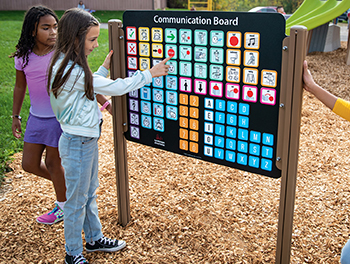
Shade: Children’s tolerance levels of sun and heat vary greatly. Providing commercial shade, either natural or artificial, increases comfort and safety on the playground. Also, it’s not uncommon for children with disabilities to be on medication that does not allow them to regulate heat. Adequate shade will keep everyone safe and playing as long as possible.
Seating: Benches with backs and arm rests, tables and game tables may be strategically located around the play area (preferably in shaded areas) for supervision, resting, snack/picnic breaks and to promote multigenerational socialization.
Pathways: Accessible pathways that transition between activity areas should
be well marked, short and direct. The Americans with Disabilities Act (ADA) requires a minimum 3 ft width—we encourage 60 inches so a pathway is wide enough for a wheelchair and someone walking next to them.
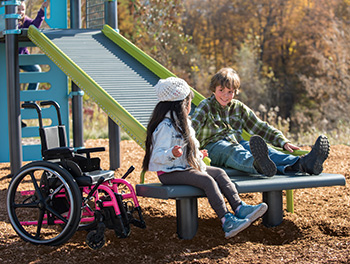 Ramps and transfer points: Wheelchair-accessible ramps and transfer modules to higher play or sliding events offers more equitable access and encourages interactive play among kids and adults of all abilities. For example, a transfer platform at the end of our Rollerslide Exit Bench allows a child to move off to the side without holding up play. This allows kids to get their feet under them and settle themselves without the stigma of stopping others from going down the slide.
Ramps and transfer points: Wheelchair-accessible ramps and transfer modules to higher play or sliding events offers more equitable access and encourages interactive play among kids and adults of all abilities. For example, a transfer platform at the end of our Rollerslide Exit Bench allows a child to move off to the side without holding up play. This allows kids to get their feet under them and settle themselves without the stigma of stopping others from going down the slide.
Protective surfacing: A truly inclusive playground should incorporate a unitary surface such as poured-in-place surfacing or rubber mats/tiles on the accessible routes.
We believe all kids are created equal.
That's why we create play environments using inclusive playground equipment that welcome kids and families of all abilities to learn, play and grow together.